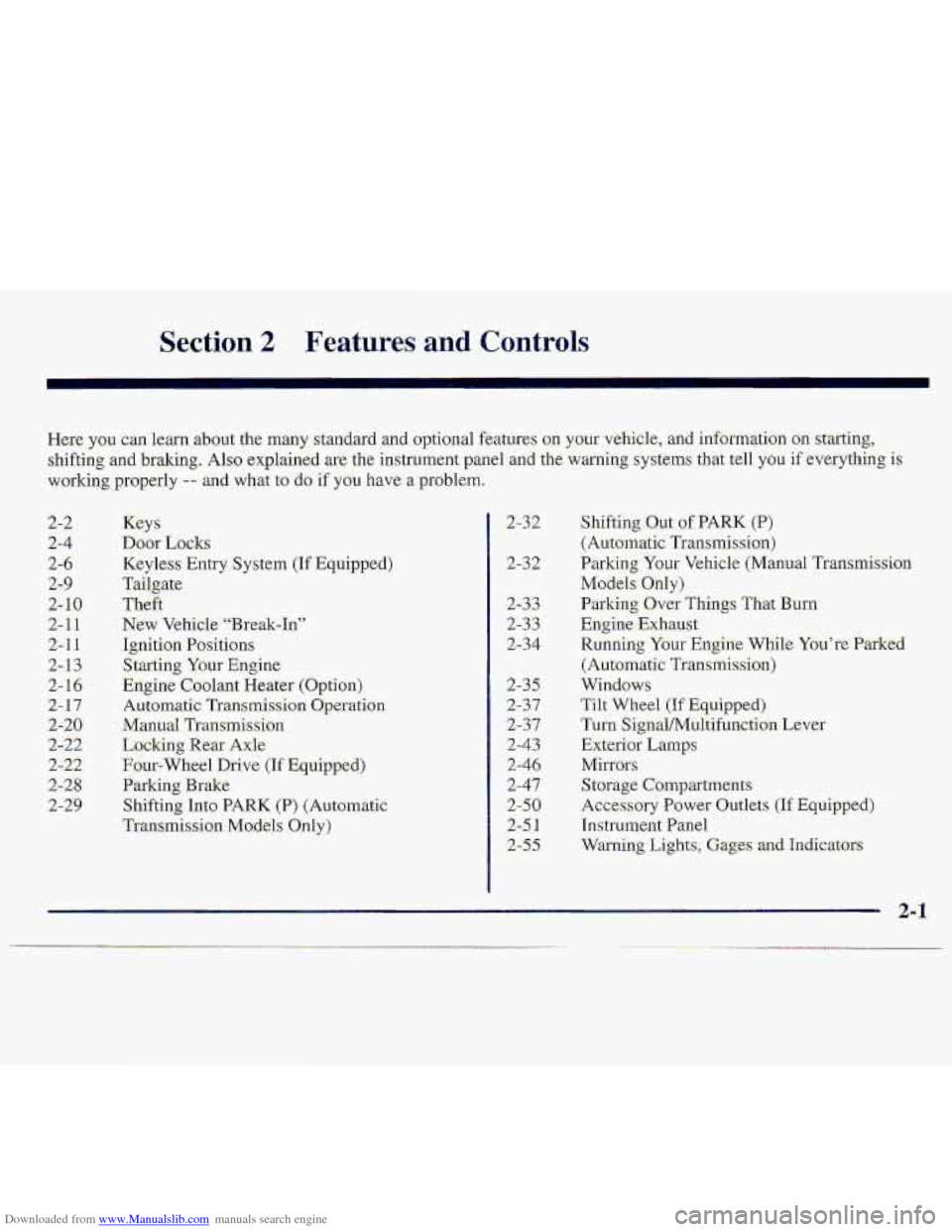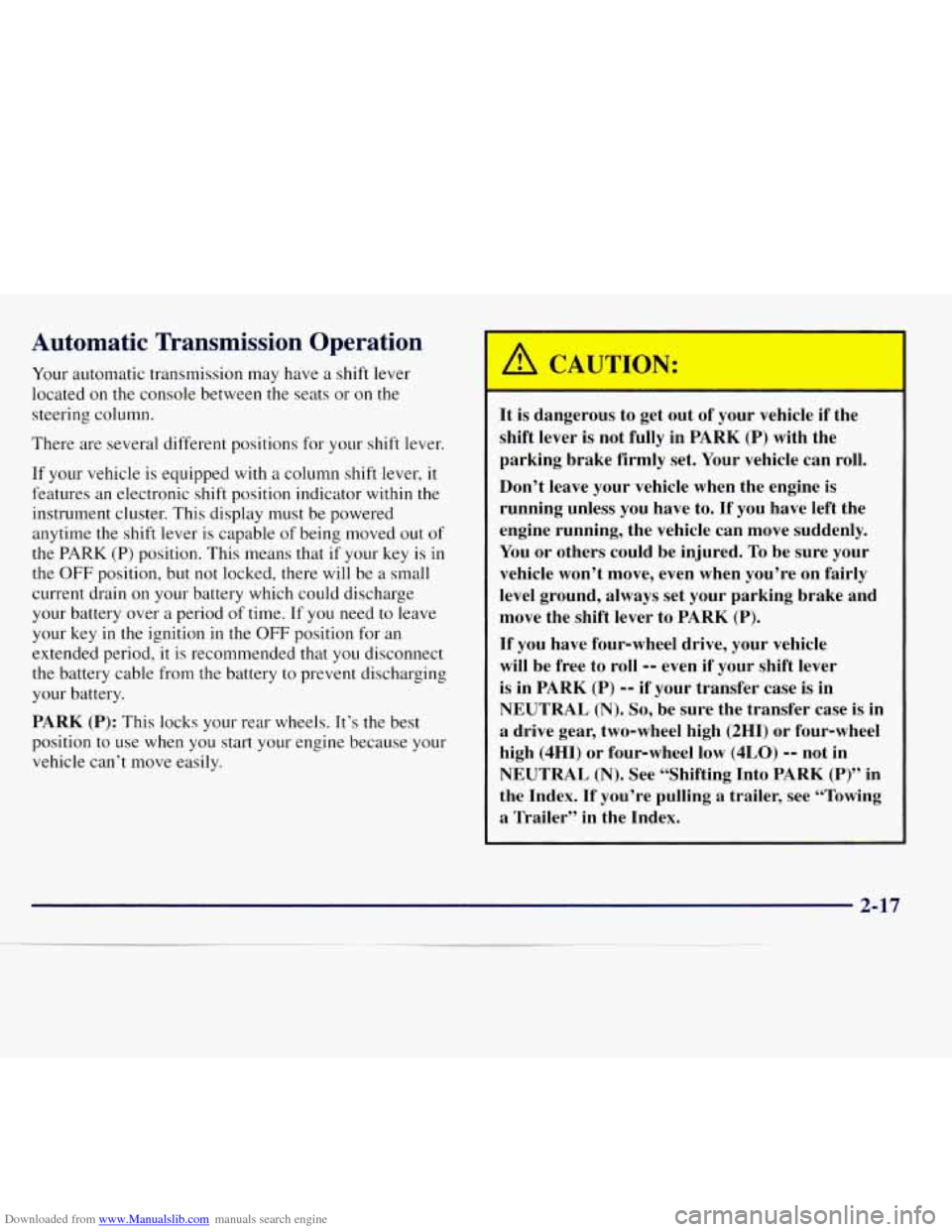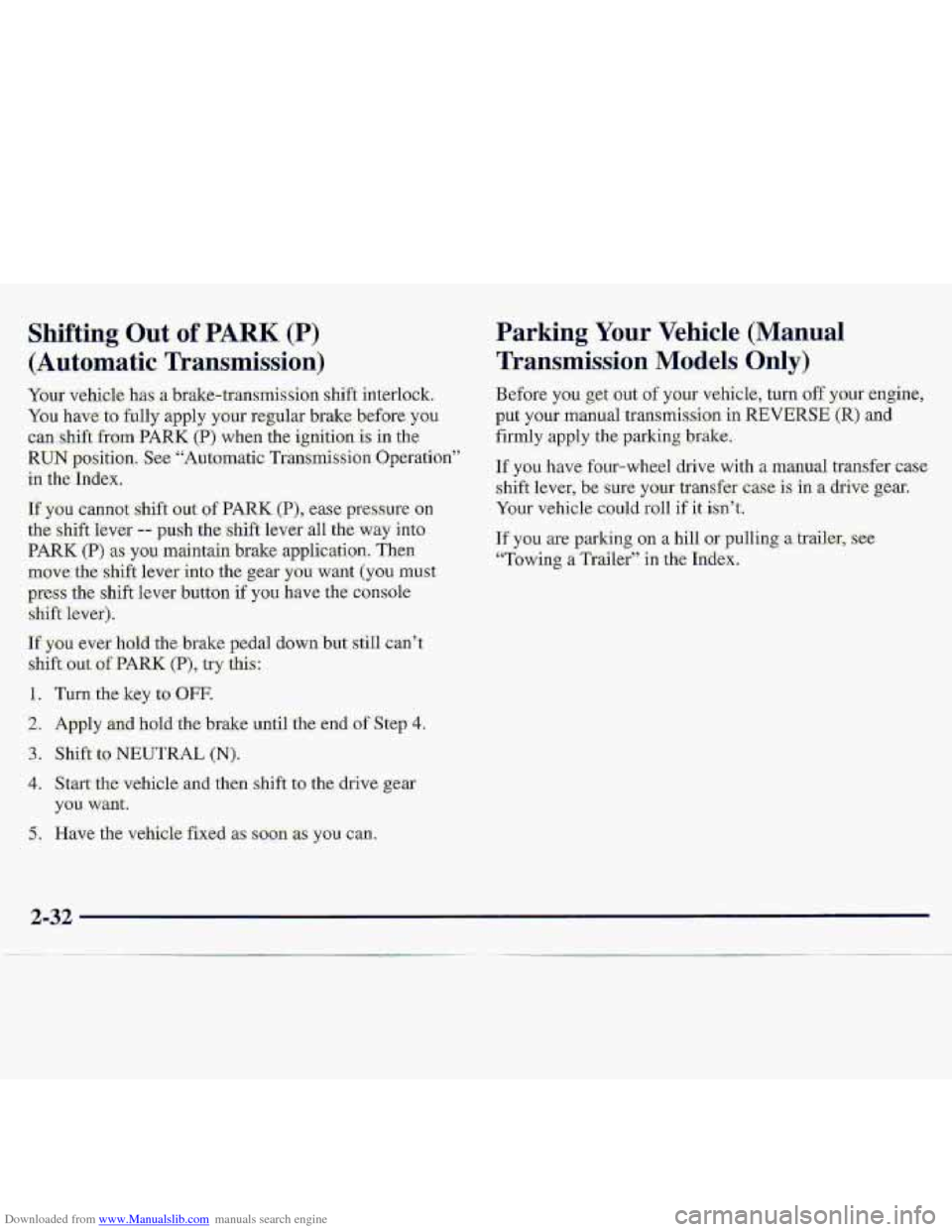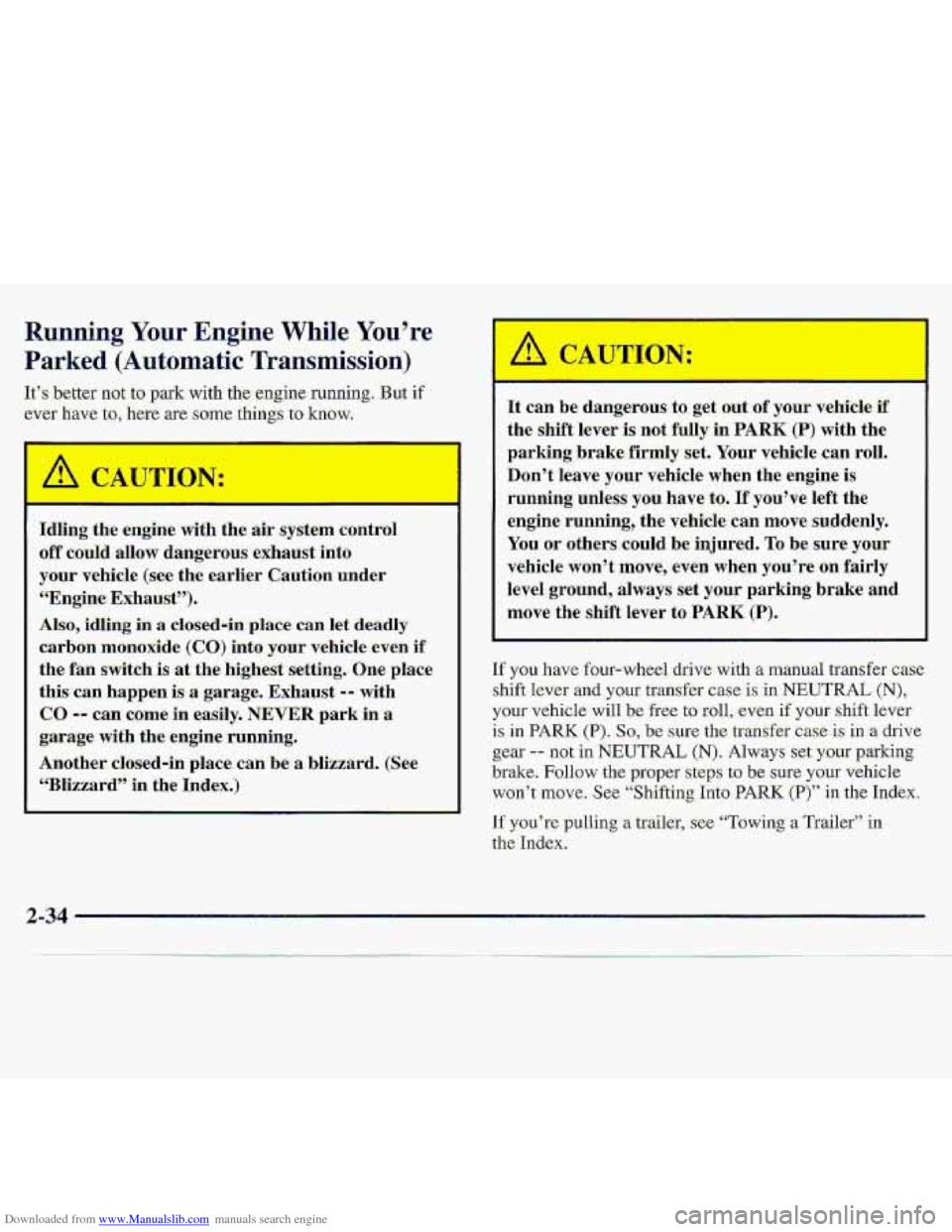Page 48 of 402

Downloaded from www.Manualslib.com manuals search engine Section 2 Features and Controls
Here y~u can learn about the many standard and opti-onal features o.n your-vehide, and irkofmation on starting,,
shifting
and braking. Also explained are the instrument panel and, the warning systems that teil you if everything is
working properly -- and what to do if you have a problem.
Keys
Door L.ocks
Key1e.s~ Entry 'System- (If Equipped)
Tailgate
Theft
Ne.w Vihicle "Break-In"
Ignition Positions
S.tarting
You Engine
Engine Coolant Heater (Option)
htqmatic. Tr.ansmission Operation
Manual Trmsrnissio,n
Locking Rear Axle:
Four-wheel Drive (If Equipped)
Parking Brake.
Shi€ting
Into PARK (P) (Automatic
Transmission
Ma.dels Only)
2-32
2-52
2-33
2-3 3
2-34
2-35
2-3 7
2-37
2-43
2,-47
2-50
2-5 1
2-55
2-4-6;
Shifting Out of PARK (P)
(Auto'mmtic Transmission)
Parking
Your Vehicle (Manual Transmission
Models Only)
Parlung Qve.1- Things That Burn
.Engine
Exhaust
Running Your EQg-ine While YGu're Parked
(Automatic Transmission)
Windows
Ti it Wheel (If Equipped)
Turn Signal/Multi~~ncti-on- Lever
Exterior Lamps
'3 t-orage Compartments
Accessory
Power Outlets (If Equipped)
Tnstrument Panel
Warning
Lights; Gap .and Tndicatms
2-1
Page 64 of 402

Downloaded from www.Manualslib.com manuals search engine Automatic Transmission Operation
Your automatic transmission may have a shift lever
located
on the console between the seats or on the
steering column.
There are several different positions for your shift lever.
If your vehicle is equipped with a column shift lever,
it
features an electronic shift position indicator within the
instrument cluster. This display must be powered
anytime the shift lever is capable of being moved out
of
the PARK (P) position. This means that if your key is in
the
OFF position, but not locked, there will be a small
current drain
on your battery which could discharge
your battery over a period of time.
If you need to leave
your key in the ignition
in the OFF position for an
extended period, it is recommended that you disconnect
the battery cable from the battery
to prevent discharging
your battery.
PARK (P): This locks your rear wheels. It’s the best
position to use when you start your engine because your
vehicle can’t move easily.
Lf! C A TION:
It is dangerous to get out of your vehicle if the
shift lever is not fully in
PARK (P) with the
parking brake
firmly set. Your vehicle can roll.
Don’t leave your vehicle when the engine is
running unless you have to.
If you have left the
engine running, the vehicle can move suddenly.
You or others could be injured.
To be sure your
vehicle won’t move, even when you’re on fairly
level ground, always set your parking brake and
move the shift lever to
PARK (P).
If you have four-wheel drive, your vehicle
will be free to roll
-- even if your shift lever
is in
PARK (P) -- if your transfer case is in
NEUTRAL (N). So, be sure the transfer case is in
a drive gear, two-wheel high (2HI) or four-wheel
high (4HI) or four-wheel low (4LO)
-- not in
NEUTRAL (N). See “Shifting Into PARK (P)” in
the Index.
If you’re pulling a trailer, see “Towing
a Trailer’’ in the Index.
2-17
Page 75 of 402
Downloaded from www.Manualslib.com manuals search engine Parking Brake
I NOTICE: I
Driving with .the:p.arking brake on c=an.cause
your- rear brakes to overheat. Y0.u may have to
replace them, and you. could .also-damage other
parts of your vehicle.
If you. are towing a trailer and.you must. park on a hill,
see--"Towing a Trailer" in. the Iadex. That section shows
what to
do first- to. ke.ep the trailer from moving.
Page 76 of 402
Downloaded from www.Manualslib.com manuals search engine Shifting Into PARK (P) (Automatic
Transmission Models Only)
It can be dangerous to get out of your vehicle if
the shift lever is not fd1y in PARK (P) with the
parking brake firmly set. Your vehicle can roll.
If you have left the engine- running, the vehicle
can move suddenly. You or others could be
injured.
To be sure your vehicle won’t move, even
when you’re on fairly level ground, use the steps
that follow.
If you have four-wheel drive with
a manual transfer case-shift lever and your
transfer case
is in NEUTRAL (N), your vehicle
wiIl be free to roll, even if your shift lever is in
PARK (P). So, b.e sure the trans€er case is in a
drive gear -- not in NEUTRAL (N). If you’re
pulling
a trailer, see CLTowing a Trailer’’ in
the Index.
Column Shift Lever
1. Hold the brake pedal down with your right,foot and
2. Move the SM lever into PARK (P) position like this:
set the parking brake.
1 I
Pull the lever toward you.
2-29
Page 77 of 402
Downloaded from www.Manualslib.com manuals search engine Move the lever rjp as far as it will ga:
.3. If you have four-wheel drive with a manual .transfer
case shiftleverj be sure the transfer case is in a drive.
gear
-- not in NEUTRAL (N).
4. Turn the ignition key to LO-CK.
5. Remove the key and take it with you. Fyou c.an
remove the key from your ignitibn, your vehicle is in
PARK (P),
Console Shift Lever
1. Hold the bvake pedal dawn with your ri,ght foot and
2. Move the -shift .lever into PARK (PI position like this:
set the ,parking brake.
0 Hold in the button on the lever.
0 Push the lever abbe way towd the front of
t-he. vehicle.
3. Turn the ignition key to LOCK.
4. Remove the key and take it with you. If y0.u can leave
your vehicle
with the key, your vehicle is in PARK (P).
2-30
Page 78 of 402
Downloaded from www.Manualslib.com manuals search engine Leaving Your Vehicle With the Engine
Ru-ming (Auto,matic Tra mission
Models Only]
It can be dangerous to leave ; LXF -vehicle with the
engine- runnin.g. Your vehicle could move: suddenly
if
the shift lever is 'not fuUy in PARR (P) with the
parking brake. firmly set. If you: have fo-ur-wheel
drive
w.ith a manual transfer case shift lever and
your transfer caseis in
NEUTRAL (N), your
vehicle. will be free to roll, even if your shift lever
is-in PARK (P). So be sure- the transfer ,case.is in a
drive .gear -- not in NEUTRAL (N). And, E you
leave. the .vehicle with the engine running; it could.
overheat and even catch fire. You or others could.
be injured. Don'? leave your vehicle with the
engine rummg. unless you have to.
Page 79 of 402

Downloaded from www.Manualslib.com manuals search engine Shifting Out of PARK (.P)
(Automatic Transmission)
Your vehick has a brake-transmission shift biterlock.
You have to fully apply your regular brake before. you
can :.shift from PARK (P) when the i-gnitlon is in the
RUN position. See- “Automatic Transmission Operation”
in the Index,
If you cannot shift out of PARK (P), ease pressure on
the shift lever -- push the shift lever all the way into
PARK (PI as you maintain brake application. Then
move the shift lever into the gear you want (you must
pms the shift lever button if you have the. console
shift lever).
If you ever ho1.d the brake pedal down but still can’t
shift out
of PARK- (P), try this:
Par g, Your Vehicle (M-anual
Transmi,ssion Models Only)
Before you-get out of your vehicle, turn off your engine,
put
y.0~11- manual transmission in REVERSE-(R) and
firmly .apply the parking bzakei
If you have four-wheel drive with a manual transfer case
.shift lever, be sure
your transfer case is in a drive gear.
Your vehic1.e
could roll if it i.sn’t.
If you are parking on a hill or pulling a trailer, see
“Towing a Trailer” in the Index.
I. Turn the key to OFF.
2. Apply and ho-18 the brake until the end of Step 4.
3. Sliiffto NEUTRAL (N).
4. Start. the vehicle and then shift to the drive gear
5. Have the vehide fixed as soon as you can.
you want.
2-32
Page 81 of 402

Downloaded from www.Manualslib.com manuals search engine Running, Your Engine While Yo-u’re
Parked (Automatic Tr-ammission)
It’s better not to park with the -.engine running. But if
ever have to, here are some things to knbw.
Idling the engine with L; air system control
off could allow dangerous exhaust into
yom.-vehicle (see the ear1ie.r Caution under
“Engine Exhaust”).
Ab, idiirig-in a. closed-ili place can let deadly
carbon monoxide
(Ca) into y.our vehicle even if
the fen switch is at the highest Setti.ng. One place
this can happen
is a ,garage. Exhaust -- with
CO -- can come in easily. NEVER park in a
,-garage with th-e engine runnihg.
Another cl~sed-in place
can be a. blizzard. (S.ee
“Blizzard” in the Index.)
r
It can be dangerous to get aut.of your vehicle if
the shift lever is not fully in PARK (P) with the
parking brake-firmIy set, Your vehicle c.an roll.
Don’t leave your vehicle when the engine is
running unless you have
to. If you’ve left th.e
engine runnhg, the vehicle can
move suddenly.
You
or others. could be injured. To be sure your
vehicle won’t move, even when you’re bn fairIy
level ground, always set your parking brake -and
move the shift 1-ever-to PARK (P).
If you have four-wheel drivecwith a manual transfer case
shift lever and your tKans-fer case .is in.NErJTRAL. (N),
your v8hicle will be free to roll, even if your shift lever
is in PAR.K (P). So, be sure the tran-sfer c.ase is in a drive
gear
-- not in NEUTRAL (N). Always-set y.our-p.arking
brake.
Follow the proper steps to be sure your vehicle
won’t move. See “Shifting Into PARK.(P)” in the Index.
If you’re pulling a.trailer, see “Towing a Trailer” in
the Index.
2-34